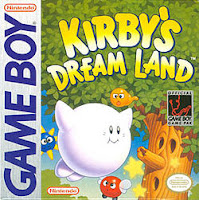3. Kirby Super Star (SNES, 1994)
Any game that has the phrase “Six games in one!” on its title is just asking for trouble. Games that try and be compilations generally fail miserably and play terribly, as they try to do too much and can't handle any of it.
Kirby Super Star is an amazing exception.
While the box art says that there are six separate games, think of each game in Kirby Super Star as a separate Kirby idea that wouldn't pan out to a full game on its own. They're interesting enough, like making your special powers something you find throughout the world and can use at any time, or having Kirby do a large treasure hunt. By putting them all together, it makes for something much, much better.
There are just so many ideas in Super Star. For example, one mid-level boss is a turn-based battle that looks just like an old-school RPG. One power makes you cling to the walls and enables you to vanish in a puff of smoke when you're damaged. The game turns into a side-scrolling shooter at one point, and one game is a timed offensive where you desperately try to destroy Meta Knight's ship. Really, there is just too much to go on about here.
Kirby Super Star also includes drop-in multiplayer, great bosses, varied locales and sharpened-to-a-point controls. The recent DS re-release is even better, with even more ideas, including a separate game for Meta Knight himself and full animated cinematics. If you like Kirby games at all, pick it up.
2. Kirby’s Dream Land 2 (Game Boy, 1994)
Kirby’s Dream Land 2 was packed full of cool moments, and it’s hard to believe they fit the whole thing in a tiny little Game Boy cartridge.
Here’s an example: Throughout the game, there are special bricks that can only be broken by certain special powers. Toward the end of one level, you come upon long corridors that lead up to three doors. Two are blocked by the special bricks, and one is wide open. If you go through the wide open door, you reach the end of the level. So what’s behind the other doors?
If you break the special bricks and enter one of the doors, you find yourself in a similar corridor with different special bricks. Go the wrong way and you end up at the end of the level with no special destination. So what are you supposed to do?
Well, early in the level there’s a darkened room. If you use the electricity power in conjunction with your animal friend Kine the Fish, it lights up the room. When the room is lit, you see tiles on the back of the wall that show the order in which you need to destroy the special bricks in the end of the level. Follow that order, and you get a special item that helps you achieve 100% completion in the game.
That’s the sort of thing I’m talking about. That’s a surprising amount of depth for a Game Boy game that looks like a simple platformer at first glance, and one of the reasons that Kirby’s Dream Land 2 deserves to be remembered as one of the greats.
1. Kirby’s Adventure (NES, 1991)
Kirby games always are cursed to show up late in a console's usable life. Kirby 64 showed up after everyone had moved over to the PS2. Kirby Super Star showed up in 1996, a week before Super Mario 64 launched. Kirby's Dream Land 2 showed up in 1994, when the Game Boy was moving toward the Game Boy Color. No game suffered more indignity than Kirby's Adventure, a sprawling epic of a game that showed up in 1991, after everyone had already set aside their NES consoles in favor of the 16-bit generation.
Kirby's Adventure stands alongside Super Mario 3 as one of the best games of the NES generation. Huge bosses, inventive levels, tons of powers (including the UFO power, the best Kirby power ever), bunches of secrets, and genuine challenge. You're not going to find a better Kirby game than Kirby's Adventure, and it's a fantastic achievement that's still fun to play 20 years later.
__________
Agree? Disagree? Tell us in the comments!
































